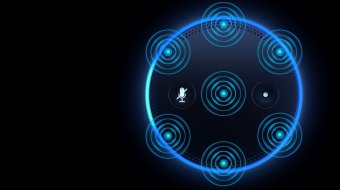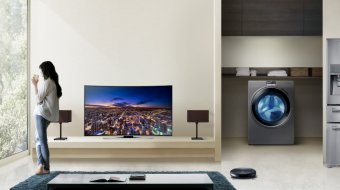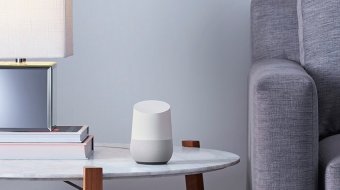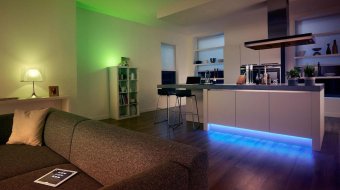Seemingly, not a day goes by without the launch of a new Thing to join the burgeoning Internet of Them. A smart toaster here, a connected speaker there, a robot vacuum cleaner that you last saw tormenting the cat who knows where. But for all these new products, and the cutesy ukulele-and-glockenspiel soundtracked ads conveying their benefits, is home automation for the masses really finally becoming a reality? Because, believe us, we’re ready.
A brief history of smart home
Back in 1966, while everyone else was busy watching the World Cup and debating whether The Beatles’ Revolver was bonkers or brilliant, engineer Jim Sutherland was at home in Pittsburg, quietly creating his ‘Electronic Computing Home Operator’.
The ECHO IV – and no, we’re not sure what happened to the first three – could be controlled via panels dotted around the Sutherlands’ home. It could store recipes, write shopping lists, keep tabs on the family calendar, control home temperature, turn appliances on and off and predict the weather. This was much to the consternation of Mrs S, who worried aloud to one journalist, “At first, I thought it might really replace me!” Poor woman.
Incidentally, the ECHO IV it was just about the size of Samsung’s smart Family Hub American-style fridge freezer. To say Sutherland was ahead of his time is an understatement…
It would be another 44 years before the designer of the iPod, Tony Fadell, took a similar step towards revolutionising home automation with his groundbreaking Nest Learning Thermostat. A wave of launches followed – Samsung announced its SmartThings ecosystem in 2012, though arguably its thunder was stolen by Philips’ Hue lighting system. Belkin’s WeMo app-controlled plug socket arrived at CES in 2013, and by 2014 any tech brand worth its salt was talking smart home, from LG with its HomeChat textable appliances to Apple and HomeKit.
Some people still see smart home products as overly complicated for day-to-day use
2015 saw the democratisation of the smart home, as more niche products from smaller players hit the scene. Smarter followed up its Wi-Fi kettle with a connected coffee machine. The Parrot Pot promised to keep your houseplants alive by watering them for you. Oh, and Netatmo Welcome-d you home with a smart camera capable of recognising your kids’ faces.
According to a 2015 study by GfK, 66% of UK consumers and 78% worldwide agreed that the smart home was an appealing concept, but just 25% of consumers in the UK owned at least one smart home device. That was then. So, did things move on in 2016?
Where we are now
“Smart home is still a category with relatively low consumer awareness,” says Katrina Mills, buyer for Audio and Connected Home at John Lewis. “One issue is that customers perceive smart home products as overly complicated for day-to-day use.”
Another is that they struggle to see the benefits in the first place. “For those of us that aren’t tech-savvy, it’s not been made clear how smart home devices can transform our lives for the better,” says Nina Bhatia, managing director at Hive. “But we’ve seen that when our customers do experience what smart home has to offer, it’s a real ‘a-ha’ moment.”
Nevertheless, smart home is a hit for John Lewis, and its in-store experiences at Oxford Street in London, Leeds and Southampton in the UK have proved useful in getting the benefits across. “We’re planning to bring more of these story-telling environments to Edinburgh and Oxford branches later this year,” says Mills.
What products are doing well? “One clear growth area has been smart lighting from brands like Lifx and Philips Hue,” she continues, who puts strong sales down to their benefits being obvious to customers. “But home monitoring is our fastest growing category, with Nest, Panasonic and the Netatmo Presence proving the most popular. We’re seeing a lot of interest in outdoor cameras, like the new Canary Flex, too.”
Heating is also a big smart-home success story. “We now have over half-a-million Hive hubs in UK homes,” Nina Bhatia tells us. “The reaction has been really positive, with satisfaction ratings around 90%.” And, tellingly, “Customers with multiple devices, like our smart lights, plugs and sensors, are more likely to recommend Hive than those customers with just one product.”
It’s a similar tale over at Panasonic. “When we first launched our Smart Home system, we were about the only manufacturer with a big range of sensors, cameras and so on,” says Justin Burnell, Panasonic UK’s smart home marketing manager. “Since then we’ve seen a significant uptake in sales, but we’ve also seen people coming back to buy more accessories. People are buying into it, using it, and thinking about what else the system can do for them.”
Making a connection
This exposes another big issue in the current smart-home climate – connection. Different brands are taking very different approaches to connectivity, working not just with Wi-Fi and Bluetooth, but also Thread, ZigBee, Z-Wave and DECT ULE.
This means creating ‘scenes’, where one action (say, coming through the front door of a evening) triggers a series of reactions (the lights come on, the kettle boils, the TV powers up), isn’t as straightforward as it could be, unless you stick with a certain ecosystem, such as the various ‘Works with…’ offerings from Samsung SmartThings, Nest and Apple HomeKit.
So why the difficulties? “We took the decision when we launched that security was very important, so we use a closed system on DECT ULE,” explains Justin Burnell. “One benefit is that if you’re searching for a Wi-Fi hotspot you won’t see one of our cameras, whereas you might with other brands.”
2017: The year of voice
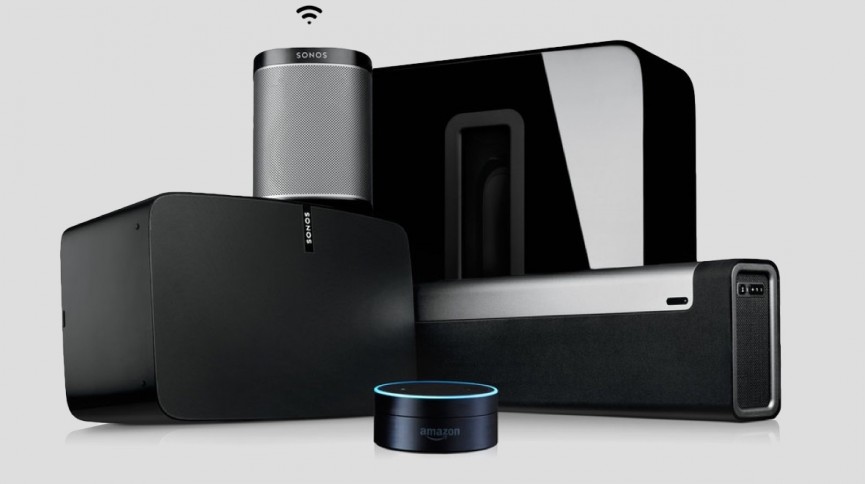
Like Ant and Dec, the Echo and Echo Dot will chat to just about anything
Amazon Echo and Google Home are undoubtedly the stars of smart home in 2017, and it’s not surprising. In a world where multiple incompatible ecosystems continue to baffle consumers, these seemingly simple smart speakers have built-in, far field microphones and friendly artificial intelligence inside.
Both have their strengths. For Amazon, it’s currently compatibility. Like Ant and Dec, the Echo and Echo Dot are happy to chat to just about anything. They can control your Nest, Hive and Tado heating, Sonos and Bose SoundTouch speakers, Hue lighting, TP-Link smart plugs – just ask Alexa.
And it doesn’t stop there. Amazon has just made its Alexa Voice Service and its echosim.io online tool available to manufacturers and developers looking to integrate voice control into their products. Logitech is one of those taking advantage, with plans to integrate Alexa into its ZeroTouch smart car phone holder and voice-command app. But it’s Ford that’s been the first to bring Alexa inside you car, with the C-Max.
By comparison, Google Home is on speaking terms with limited smart home kit – that’s Samsung SmartThings, Hue, Belkin WeMo and Nest and Honeywell thermostats, although the list is growing all the time. Plus Home gets on famously with Chromecast, so there’s scope for controlling your TV and speakers. And, not surprisingly, Google Home excels at search.
There are already signs that voice control is kick-starting the smart-home revolution as higher Echo sales translates to higher sales of everything else. “Amazon Echo has been a runaway success for John Lewis as a smart-home control,” reports Katrina Mills, “and we’ve seen incremental sales increases of smart home products compatible with Echo, including Nest, Hue and Hive. We’re expecting that the recent announcement around Sonos’ compatibility with Alexa, along with Bose multi-room audio’s existing compatibility, will benefit connected audio products, too.”
Beyond lights, heating and security
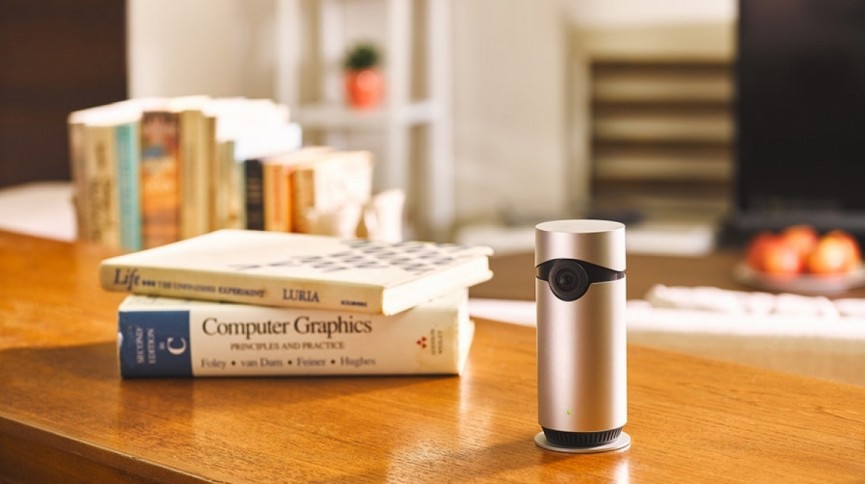
Amazon and Google aren’t the only ones with dibs on voice control. At CES 2017, Samsung announced an upgrade to its Family Hub fridge freezers – Family Hub 2.0 features its own S-Voice assistant that will respond to commands and do handy things like read out recipes as you cook. You can access more through its 21.5in-touchscreen, too, including Spotify and grocery shopping from Lidl. Incidentally LG also showcased a voice-controlled fridge at CES, powered by Alexa.
Elsewhere, others are expanding their offerings and what the smart home can do. Hive is looking to launch a leak sensor, Panasonic has announced it’s working on a thermostat, and in spring 2017 will release an HD indoor camera with a 142-degree wide-angle lens and a privacy shutter that slides up to cover the camera and mic.
Netatmo is taking on Nest with its own smart smoke alarm, compatible with various systems including Apple HomeKit, and has also teamed up with Velux to create Active windows that can open and close depending on the temperature and indoor air quality.
Talking of Apple, Cupertino are remaining tight-lipped about future plans for HomeKit. There are rumours of a Siri-based rival smart speaker hub for Google Home and Amazon Echo, but right now finding compatible hardware remains tricky. Fans of the system can take small comfort in a couple of upcoming launches – D-Link’s Omna 180 Cam HD security camera, the Withings Home Plus and Elgato’s EVE smoke detector.
Are you being served?
Voice might be the biggest story of 2017, but while manufacturers wait to see who will win the battle for wireless standards in the smart home, they’re focusing on additional services they can offer around their products, such as insurance.
In 2016, Panasonic launched a German partnership with insurer Allianz to provide home-protection services around its smart home products. If unexpected motion, glass breakage, or a water leak is detected, the system will send an alert to your phone, activate the indoor siren and notify Allianz. Their service team will then contact you and take steps to minimise the damage, for example, by sending some to replace a broken window, repair a leaking pipe, or by getting its security to investigate. At the minute, these services are only available in Germany but it is already experimenting with pet monitoring kits and Petplan insurance bundles in the UK. Hive too, is having discussions in this area of home protection.
The future of the Internet of Things remains to be seen, but could voice control be the beginning of the end of the compatibility issues that have dogged its uptake? We think it’s possible. Meanwhile, there are plenty of positives to be taken from the smart-home story. Its applications within health and elderly care, and its potential to improve the quality of our sleep, diet and mental wellbeing, are too exciting and important to ignore.
If everyone can just work out how to play nicely together, the smart home, not to mention the smart car, smart hospital, and even smart airport, might not be too far away after all.
